|
Earth Horses |
The discovery in 1995 of seven thousand perfectly preserved horse-effigies in the baked earth of Xiang-Tan province (Xiang-Tas plateau) 1 provided the missing piece that enabled us to view for the first time a mosaic of elemental horse-worship that extends back through the millennia and will eventually prove to encompass all the world's major civilisations. |
|
Alpha = horse
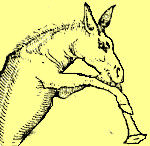
|
Traces of this cult remain in folk memory: the wooden horse of Troy; the chalk hill-figures of Celtic Britain; the Aboriginal ritual of 'aoraoraora' (= William Blake's 'chariot of fire') 2; and of course the form of the horse itself has remained at the forefront of our culture as first letter of our alphabet, the 'a' which in early writing is an ideogrammatic representation of the Divine Horse (the Piper) itself as our illustration3 (left) clearly shows. |
|
Four elements |
The elements of fire, air and (predominantly) water have continued to fascinate students of the horse-cult, but until the discovery of the Earth Horses of Xiang, little had been written about the fourth element. The new work in Tas province suggests that we can now postulate with enhanced confidence the existence of a pan-global horse-cult, preceding by as much as ten thousand years the Christian era of the fish, the Minoan bull-culture and the cat and ram worship that has characterized various Egyptian civilisations. |
|
Fisher of men |
This paper will set out to show how elemental horse-worship has informed the work of prominent artists in the historical period and, furthermore, how it has been crossed and thwarted by the adherents of other cults, most notably of course the Judaeo-Christian consensus under Christ, the fisher of men. |
|
Aqua = equus |
In elevating the water of baptism to the centre of his own Mystery, Christ 4 was subjugating the life-force of the horse-cult in a typical act of hermetic colonialism: to commute 'aqua' (venerated at woodland altars (= nemeton) across Celtic Europe) into 'equus' (= horse) was not simply a creative play on words, it was an act of unparalleled ritual imperialism. |
|
Walrus = horse |
For the first flowerings of the horse cult we must look to the river worshippers of Mesopotamia 5 and beyond, to the Greek Hippopotamus6 (river Horse) and to the Scandinavian 'Whale-Horse' (hvalross6, or walrus). Sceptics may locate our admiration for such large beasts in their sustained ability to defy an element inimical to our own species. Such a reduction denies the innate spirituality of all matter. |
|
Musical context |
But place the water-horse in its cultural context, in between Xiang's earth horses, the flaming horse of the Maori, and the HimmelPferd 7 or winged horse of the Gothic adepts, and the one true link begins to emerge: these are cults whose innermost mystery is always celebrated by music and is accompanied by rhythmical manifestations of every sort. |
|

|
|
Cult musicians
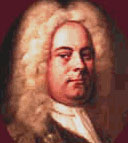
|
Culme Maddox 8, the cult's major European historian, has exhaustively investigated the hermetic art of the lute-maker Georg Böhm (1661-1733), Reinhard Keiser and the Hamburg Opera (1674-1739), and the Lollard, Christian Ritter (1645-1717). Highest adherent, and chief apostate martyr of the HimmelPferd tendency, was the composer G.F. Handel, spiritual ancestor of an art-music 'stable' that continued to flourish throughout the arts of the Western Hemisphere , right up to the art-rock cult of the 1960s, where it had its first, and crucial, opportunity to achieve world-wide saturation coverage through the spread of the new media. |
|
Lennon and
art-rock |
We shall be looking at pan-global cults of that time such as that of the Beatles 9, whose proclamation 'I am the walrus' ( = hvalross) was one of few rock-music manifestations of the horse cult to escape the censorship of a predominately Christian music-industry. But John Lennon, the Beatles' poet, defensively presented his proclamation of Godhead in the guise of nonsense, in the fashionable acid-vocabulary of his day. Not so Georg Fredrick Handel. |
|
Eternal Alpha
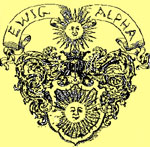
|
Handel was the most openly evangelical of his circle in the HimmelPferd of Northern Germany. Driven by the cultish creed that the artist must do all in his power to promulgate the mystery, while at the same time safeguarding the interests (commercial and artistic) of his 'stable', Handel set the Gnostic motto, 'Ewig Alpha' (The Eternal Alpha = horse) to rhythmic music as the climax of his Heilige Messe for St Walpurgis (now disputed: see footnote 10). |
|
A Christian traitor |
The holiest adepts (The Doctorate 11) of the order insisted this Mass be sung at HimmelPferd conventions over a period of almost thirty years until (under what compulsion we cannot tell) Handel suddenly 'stole' back the music he had composed, re-casting it as the climax of his oratorio, Messiah12. |
|
Ewig Alpha
= Hallelujah |
How can those Eighteenth-century Christians who rejoiced at the exaltation of that 'Hallelujah' have turned a blind eye to the knowledge that a previous congregation had sung 'Ewig Alpha' (= Eternal A) to the very same cult rhythm? |
|
Musician as
sacrifice |
Like Mozart before him, who had used Masonic ritual to underpin the story and the music of The Magic Flute 13, Handel's life did not last long after this betrayal. We should not underestimate the power nor the ruthlessness of the publishing and music industries both of which, incidentally, have conspired to suppress my own attempts14-23 to broadcast these cult findings in their respective media. |
|
Ewig A
= Evil Eye |
Insider report suggests that (to this day) the Ewig Alpha motto is intoned as adepts are received into the order. Robed in white silk, they are inducted beneath an image of the Equine Eye (Christians superstitiously refer to this motif of the eye-in-pyramid as 'The Evil I', as that is how a non-Germanic speaker is likely to hear the chant of 'Ewig A') and dedicate their art to the furtherance of the divine horse credo. |
|

|
|
Injustice |
The full winged-horse adept will use his art to further the name and the renown of his society, and this sets him instantly against the predominantly Christian vested interests of his era. Ever since the 1960s the same hegemony has been quite unjustly enforced by the controllers of supply and demand in the US record industry and in Britain. |
|
Procul Harum |
John Lennon's capitulation (he dressed his divine beliefs as nonsense) is a paramount example of course; but there were other 1960s flower-power bands which contained HimmelPferd adherents. One such was Procul Harum whose song-writer, Keith Reid 24 ( = Rider), wrote cult-based songs that were suppressed by their Christian record company in 1967. |
|
Initiation
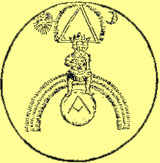
|
One, explicitly named Alpha 25, openly concerns a one-eyed idol; another, Pandora's Box26, dramatizes the circumstances of an acolyte's initiation:
Cock Robin views his frozen feet,
and wraps them in a winding-sheet
Cock Robin 27 is the name of the guitarist who plays on the song and the winding-sheet is the silk, of course, by which the adept signifies his casting off of the robes of his immediate (= Christian) culture as his soul passes beyond the veil of his own time into a transcendental reality of the horse cult itself. |
|
Pandora
= Eve |
The title Pandora's Box is not without significance, though only an initiate would appreciate how it refers to the release of secrets (= of the HimmelPferd order) into the world. Pandora is the pre-Christian version of Eve 28: until the 11th century Irish kings symbolically mated with her, and the myth in which she lets the secrets of the gods escape from the box corresponds closely to the Judaeo-Christian legend of the Apple of Knowledge. |
|
Apple
= Alpha |
We may speculate that if Reid had recorded with Lennon's Apple Corps 29 he would have been allowed to sing his song openly at the time. But it may have been his own decision to withdraw it, perhaps advized by the Doctorate, who may have been anxious that he should avoid the fate meted out to his fellow-organist Handel two centuries before. |
|
Pegasus
= HimmelPferd |
Another line acknowledges this precedent:
While Handel plays his melody
the Doctors cause uncertainty
While the song ends with ordinary horseman who ride (= Reid) only 'across the green' while Snow-white 30 (the white robe of the acolyte) remains 'unseen'; only the initiate will hear Pegasus (an unvarnished reference to the winged horse-god of the Bavarian31 HimmelPferd Order) communicate his 'messages by Morse'. |
|
Morse
= walrus |
We shall return to this theme below, pausing only to remind the reader that Morse is the French word 32 for 'Walrus', Lennon's ostensibly drug-related cognomen. So why is Reid (a HimmelPferd man) here promoting the (rival) force of the water-horse, (= hvalross)? If his spiritual quest was turning him away from his Pegasus god, why was he not drawn to the earth-horse whose effigies33 adorn the chalkhills of Reid's native southern Britain? |
|

|
|
Primeval split |
Research cannot determine the extent to which different elemental lodges of the Horse Cult have cross-fertilized. Spiritually the air and water elements appear to have become closely intertwined in European culture, while the dispersal of the Earth and Fire branches to the eastern continents of China and Australasia suggests that we may be dealing with an almost primeval split, one perhaps associated with the expulsion from the Garden of Eden 34 |
|
Fall from Grace |
The Fall of Man, and the equation of the Apple (= Alpha) of knowledge with a panacea, is also a theme frequently adapted by Reid in his hermetic writings. In one song 35 a woman wanders through the garden (= Eden) to offer her partner something that will bring 'relief from all his suffering' although the result, for him, is torture; in other songs characters fall from grace frequently; themes of flying are commonly encountered, often with a heavy fall as a consequence of their hubris. |
|
Christians
placated |
By annexing the discourse of Christianity Reid eventually placated the record industry but it was still ten years before he was able to sing Pandora's Box in public. Meanwhile perhaps under Handel's influence he developed a subtle rhythmic device to communicate his steadfastness to fellow cultists. |
|

|
|
Secrets of
rhythm |
This simple rhythm occurs with hypnotic insistence throughout Keith Reid's revelatory Shine on Brightly 36, a transcendental track, guaranteed to lodge its subliminal information deep in any listener's consciousness.
If anyone were to doubt the signal importance of this rhythm, however, if should be noted that it also occurs in a later track 37 on the same side of the same 1968 album, in which the singer declares
If you understand just what I'm trying to say
Whatever you do don't grin, you'll give the game away |
|
Messages by
Morse |
Listeners at the time might well not have understood 'just what I'm trying to say' although the cognoscenti might well have 'grinned' in understanding; but if the Christians or Lennon had cleared Pandora's Box for release in 1967, the world would have been left in no doubt by these words that unequivocally relate to the cult:
Pegasus the winged horse (= HimmelPferd)
Relays his messages by Morse
Let us superimpose this Gnostic rhythm on the Morse (= walrus) code for international communication: |
|

|
|
Revelation |
Once the 'Morse' idea has entered the listener's mind the extra-musical cult content of the Shine on Brightly track becomes apparent: the piercing and insistent guitar is actually relaying its message by Morse on the HimmelPferd cult's behalf, as can be seen below: |
|

|
|
Christian hatred
outwitted
|
Here, written plainly for all to see, is the Horse-Cult's primary mantra, Alpha the Eternal, outwitting any censor's brutality and escaping to 'shine brightly' in the world beyond the veil. Such covert brilliance far outstripped the sophistication of most of the beat-group's contemporary rivals. |
|
Fall
from grace |
The Procul Harum never again achieved such a daring publication of the Cult's messages (it was not needed, after all: in using their art to force the 'Ewig Alpha' message into the public realm they had done all that was required of them by the Doctorate to achieve Alpha status themselves). |
|
Scandinavia
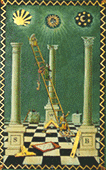
|
Like Handel's own circle, the beat group was split by dissenters who increasingly distanced themselves from another member, Gareth Brooker 37, who (significantly) was exiled to Scandinavia, possibly graduating from Alpha to the level of a Delta master, and thus putting an end to his musical performances. |
|
Before this happened, however, another of Reid's songs, from 1970, depicted another initiation into the order, probably required by the fact that another musician, Christopher Copping 38, had joined the beat group. Here the initiation is explicitly painted in the sung words, with clear reference to 'God's aloft' and 'the evil eye (= Ewig A) on high' (see illustration). |
|
Piggy wiggy
wiggy |
Once again the song exploits the Morse (= walrus) rhythm notated above, and this time members of the beat group can actually be heard chanting the Ewig A Ewig A mantra, although this is meaninglessly written down, in the track-listing, as Piggy Pig Pig 39, probably in a Lennon-like attempt to disguise the Gnostic content of the song as rubbish. |
|

|
|
Adam
Weishaupt |
The troubled story of Pandora's Box took a turn for the better in 1973 or so, when the Procul Harum beat-group performed it live in America, albeit with crucial lines omitted. Drawing the attention of American record-producers, they were eventually able to record the entire song which was subsequently released under the revealing title Ninth 40. But the damage was done: a public conditioned to heap scorn on sacred writings dismissed the record, as they did the follow-up record which even more blatantly promoted Perpetual Motion41 (= Ewig Alpha, the Perpetual A) and Learn to Fly42 with its straightforward references to Weishaupt43 and the design of the American dollar-bill44 |
|
The mighty
dollar
|
Fundamentally a training device, using symbols of the Renaissance 45 classical revival assembled into integrated images, the mighty dollar sets out the general HimmelPferd metaphysical scheme and shows the place of the human individual within it. I will explore the emblems of saddle and stirrup below insofar as they relate to the daily conduct of the 'stable'. Death is seen as a cure, an end to the human race: we will note in the orientation46 of the Xiang Earth-horses that the individual can, if it be the Alpha Horse's will, transcend the limitations of ordinary human life and realize a richer interior potential. |
|
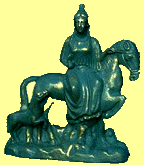
|
The water associations of horses relate to the Muses' bathing in Hippocrene, while the earth-horse's crescent footprint equates to the moon and the Islamic steed, Al Borak, on which Mohammed enters heaven. The Centaur (= man-horse) descends from the King of the Lapiths mating with a cloud (= horse of air, of course). The Goddess Epona (see illustration) significantly has no Christian equivalent, and the Virgin Mary ostentatiously maintains her association with donkeys, by way of polarisation from the more ancient myth-tree. |
|
King Solomon |
The eunuch philosophers of China 47 urged Officers of the Government to 'apply the bridle' since only men who have mastered themselves can really lead or rule others. Coming to study the musical and rhythmical applications of such an art, there is no more practical lesson in our relation and duty to Alpha, and the bridle instructs us to relieve the plight of our brothers48 and neighbors. As King Solomon49 observes, 'better is he that curbeth his steed than he that taketh a city.' |
|
Self-reverence |
In short, Handel, Lennon, Reid and Weishaupt teach us that without symmetry life may easily end in chaos and confusion 50. It has been put in many ways, but never better than in the great words Ewig Alpha: self-knowledge, self-reverence, self-control cannot compete with the gnomic gleam of such a mantra. |
|
Studio practice |
Lacking such knowledge, or disregarding it, a man goes too far, loses control of himself, and by that very fact loses, in some measure, the self-respect which is the corner stone of a rider's character. If a recording studio's practice were to be founded upon such cavalier disregard for individual liberty, one's own recordings, transactions and other melodic maxims would go down the road to destruction, like a star out of orbit, or a can into the ditch. |
|
The
Hippocampus
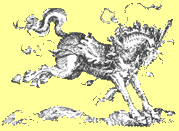
|
In Mesopotamia too the same truth was put into a Trinity 51 of maxims: 'Showeth slow, doeth sharp, sayeth more than thou knowest'. Nothing but the truth was tolerated: the Walrus in all of us cries out from the depth of its soul nothing more complex than 'I am the Walrus' and this acknowledgement makes us masters of the art of life and the life of art.
Hence the Doctorate's wise Doctrine of the Limit 52, as a basic idea both of the Hippocampus53 and of the Bounds of the Hippocampus, of which the Ewig A (= Evil Eye) is both sign and symbol. It is the wonder of our human life that we belong to the limited and to the unlimited. Hemmed in, hedged about, restricted, we long for a liberty without rule or limit. |
|
Culme Maddox |
Yet Culme Maddox shows in his masterwork that limitless liberty is anarchy and slavery 54. A rider (= man) of intemperate passions cannot be free; his passions forge their fetters.' Liberty rests upon law, whether or the sea, the air, the earth or (as the Maori believe55) the fire. The adept who takes full account of both, who knows how, at all points to qualify the one by the other, as the HimmelPferd, if he does not betray it will teach him how to do. |
|
Habit =
public opinion
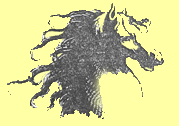
|
Much of our life is ruled for us whether we will or not. Record companies, publishing houses, even the laws of nature throw about us their restraining bands, and there is no place where their writ does not run. The Christian laws of the land seek to make us aware that our liberty is limited by the equal rights and liberties of others.
'Malice equals habit' writes Keith Reid in another unpublished song 23. Custom, habit, and the pressure of public opinion are impalpable restraining forces which we dare not altogether defy. These are un-signposted roads from which our passions and appetites stray at our peril. If we clearly see our own delusion there is no reason why our troubles should bog us down. |
|
Steely Dan |
But there are other regions of cult life 57 where personality has free play, and they are the places where most of our joy and sorrow lie: music. In a later section I will demonstrate the physiological and the psycho-sexual impact of rhythm as revealed through the simplest of private experiments58, derived (again through the application of Morse Code and its musical rhythm-equivalent) from the music of another beat-group, Steely Dan59. |
|
Our enemies
Lord |
But strangely enough, even a virtue of music, if unrestrained and left to itself, may actually become a vice of rhythm. Praise, if pushed too far, becomes flattery. Love often ends in a soft sentimentalism, flabby and foolish. Faith, if carried to the extreme by the will to believe, ends in over-belief and superstition. Such an idea is all a blur: our minds can neither grasp nor hold it.
Yet the transcendental, revealed through my solitary experiments (while dressed in white) will no longer defy the willing adept, by whose example we can seek to escape the fate of G. F. Handel (= Abraham man 60) and the other impostors. Many a man loses all truth in his impatient effort to reach final truth, and the musician or recording engineer who seeks to impose his dogma61-73 upon others becomes the bigot, the fanatic, the persecutor, the ruthless zealot. |
|

|
![]()










